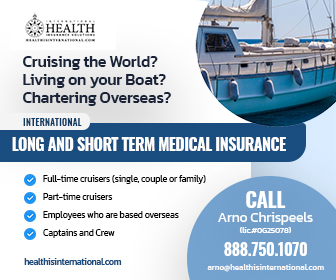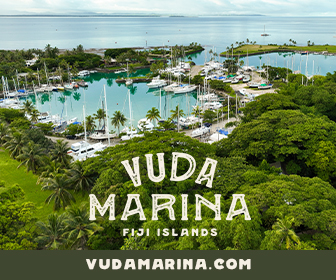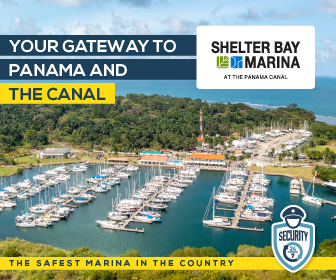Tuvalu: A Truly Beautiful Spot in the South Pacific Ocean
Planning a stop to refuel on their way from Tonga to the Marshall Islands, US sailors Captain Harry Pattison and First Mate Joy Archer, expected little from their Tuvalu stopover. However, they were delighted to find an easy, restful and truly beautiful place in the middle of the ocean and were very glad they included it in their passage plan.
Published 1 year ago
We stopped at Tuvalu on our way from Tonga to the Marshall Islands. We expected very little from this tiny country and only wanted to re-fuel with diesel and rest while we waited for the next weather window to the Marshalls.
We only visited Funafuti and no other islands/atolls or anchorages, as we were in transit mode and not exploration mode. But wow!
This little spot in the ocean is truly beautiful and lovely. It reminds us a lot of the Tuamotus with its geography and the way the town stretches a long, long way from one end of the atoll to the other with one tidy road going the distance.
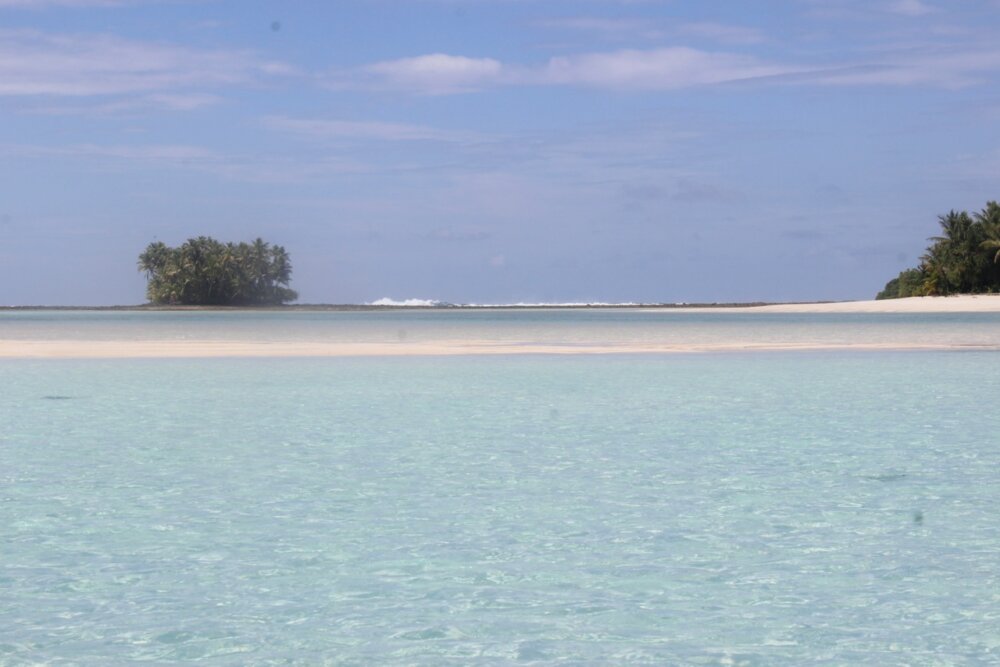

A warm and friendly welcome
The people were warm, welcoming and friendly and eager to talk with us. In Tuvalu, English is their second language and it’s taught in primary school. In secondary school, it’s required to speak English in class. This explains why their English skills are so strong.
Most people we met were fluent or nearly fluent in English, very different from any other South Pacific island we’ve visited. This reduced a lot of stress as we were able to figure out where to go to get what we needed pretty easily – as long as you can follow instructions like “down the main road a ways and around the corner you will find the fuel station”!
We’re glad we were able to stop here. It was an easy, restful bright spot in our transit from New Zealand to Alaska.
Sunday Arrival
We arrived on a Sunday after a six day passage from Tonga. Everyone knows you can’t do anything on a Sunday in the islands of the South Pacific, so we dropped the anchor and napped, cleaned up the boat and generally chilled out. It was awesome.
Monday morning we went ashore in our dinghy with its dodgy engine. The engine was Tonga-fixed, meaning that in Tonga it would be considered in excellent shape because it runs. But it dies at idle so has to be kept “revved” at all times, even when shifting into gear. It feels like a ride with someone learning how to drive, which is to say it’s simultaneously nerve-wracking and hilarious. The replacement carburetor for the dinghy engine will meet us in Majuro, Marshall Islands, our next port.
Funafuti atoll – Approach and exit
We entered through Te Avo Fuagea passage, which faces east. We had swell running east to west and moderate easterly trades blowing 15-20 kts as we approached and were concerned this might make the pass a little tricky. But it was completely calm and easy to get through. The pass is quite narrow here, but deep and easy to navigate.
We exited through the same passage with no trouble.
The Anchorage
We anchored off the government building (the tall white one – there’s only one) in about 25 feet of water with excellent holding in sand. This is some considerable distance from shore but you wouldn’t want to get closer as the reef comes up fast.
This wouldn’t be a great spot in strong winds from any direction except east. We had some strong squalls blow through with winds from NW and a day of 10-15 knot winds, also NW. The seas got a little bouncy, but the holding was so good we weren’t concerned.
We’ve been in anchorages with significantly less-reassuring elements, but being open to the north and the west in these moderate conditions was fine.
The Formalities
Clearing in
Tuvalu does not require advance notice of arrival. As of May 2023 there are no specific requirements for Covid vaccination or testing.
Upon arrival at Funafuti fly your quarantine flag. Some sources suggest calling Funafuti Radio, but we didn’t do this since we arrived on a Sunday and everybody knows nothing happens on a South Pacific island on a Sunday.
As mentioned before, we anchored off the big white building. There’s also a big pale blue roof in the same area. The white building is the government offices and the blue roof is a conference center.
When you dinghy to shore, aim for the blue roof. There’s a smaller blue roof nearer the water. This is where you’ll find a concrete wharf with two sets of stairs leading down to the water. We left our dinghy here with a stern anchor to keep it off the concrete wall.
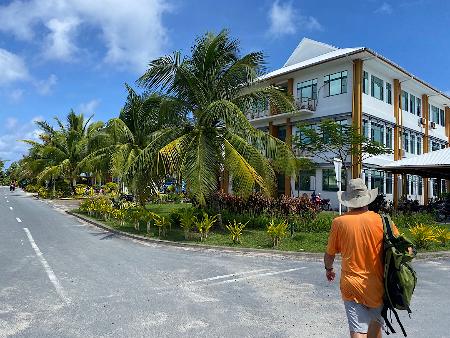

First stop is Immigration in the government building. This office is on the ground floor. Anybody can point you toward it. After Immigration you must go to the Customs office that’s “down at the wharf” which is at the northern end of the atoll.
There is another Customs office in the government building, but they do not process ships/boats. Only the Customs office “down at the wharf” processes ships.
It’s a very long walk from the government office, about 35-40 minutes. If you are stupendously lucky, as we were, the young woman in immigration who cleared you in will rally her coworker to join her in taking you to the Customs office on their motorbikes.
Alternatively, you can take your dinghy down to where the big shipping containers are and ask for the Customs office there. A third option is to rent motorbikes from the place on Tuvalu Road across from Halavai Market.
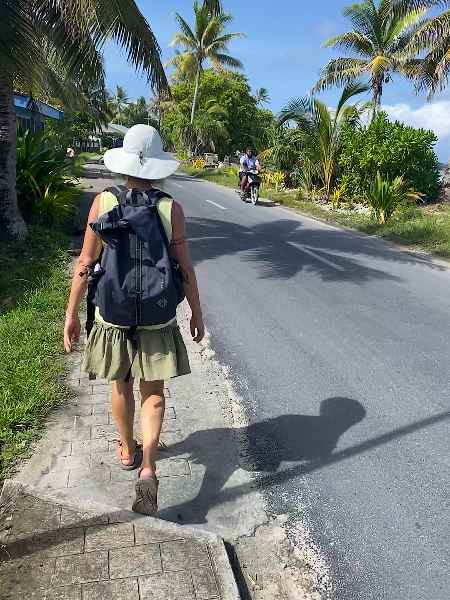
After Customs, go back to the government building for health clearance. Here you’ll need to pay a AU$25 fee, but it’s ok to come back to pay it after you’ve cleared in and visited the bank.
After health it was agriculture/biosecurity. We had a form to fill out (super quick) here and once you’ve paid your health fee you’re done.
Clearing out
First to Immigration in the government building. Then to the Customs office at the north end, on the wharf. The most time-consuming aspect of clearing out will be getting from the government building down to the Customs office at the wharf. We rented motorbikes for the day and did our clearing out as part of our motoring around.
The Tuvalu Experience
Fuel
We went into town to get diesel fuel in our six jerry cans. This was a big project masquerading as an excellent workout. Each jerry can holds 5 gallons/20 litres of fuel and weighs around 35 pounds/15 kg.
The fuel station, which is (obviously) a small blue shed next to a slightly bigger, green building with no obvious signage whatsoever, is about three blocks from the waterfront where our dinghy is tied up.
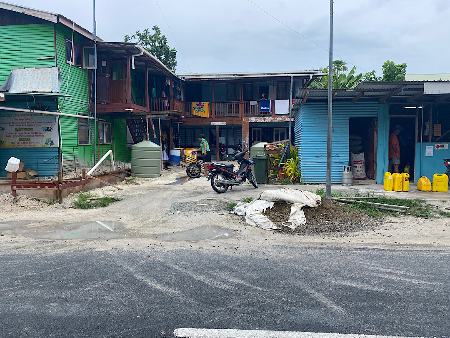

We bought diesel at $3.60 AUD per litre but they only had enough diesel for one run on our six jerry cans (we needed two runs), and they said they’d ordered another barrel to be delivered the next day. It didn’t arrive the next day, and on the day after that we had to go elsewhere because we were leaving the next day and needed our fuel.
We ask the two young ladies working in the slightly bigger, green shop (which is where we paid for the fuel) if there’s anyone to help us get our jerry cans from the blue shed to the dinghy, or a hand cart or anything that will make this task easier. First they offer their “cargo boys” – but it turns out they’re not around. So the two women set about solving this problem and come up with a cart to go behind a motorbike and one of them will drive for us. They are cheerful and kind and seem invested in making our project easier.
We’ve found it less stressful (if more work) to re-fuel with jerry cans than to try to take the big boat into a wharf we’re unfamiliar with and which generally has surprisingly few places to tie the boat up and no protection against a concrete wall. We understand there is a wharf here for re-fueling, but we did not investigate or use it.
In our explorations we found a fuel station that’s kind of hidden, off the main road toward the ocean side near the big blue supermarket. It’s called MacKenzie Trading Limited and they sell diesel at $2.80 AUD/litre. This saved us about $100 AUD and I wish we’d looked around a little more for our first fuel run.
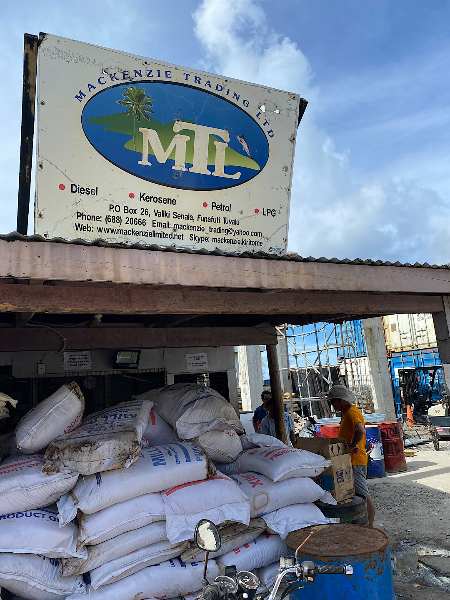
They are significantly further from the dinghy dock area but also provided us with a motorized cart and driver to deliver. We paid the two helpers $5 AUD each for delivering us and helping carry the jerry cans down to the dinghy. They genuinely tried to refuse our money and were surprised by our offer, but we insisted.
All fuel stations that we saw appeared to sell both diesel and gas/petrol as well as a gas mix.
Fuel stations are NOT obvious here. The only signage you’ll see will be a torn piece of cardboard on a shed wall with prices handwritten on it. There will also be a lot of official “No smoking” sort of signs. This is how you know fuel is sold there. There are no other signs. But ask people where to buy fuel and they’ll be able to point the way.
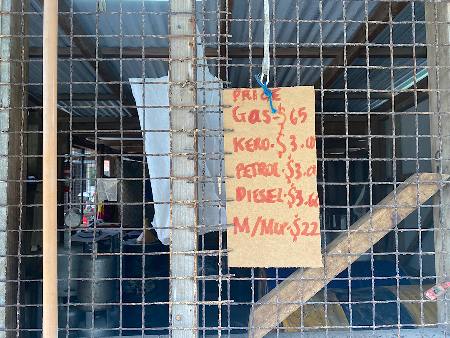

Photos
As we’re waiting for the jerry cans to be filled (the man pours it from a spigot on a big barrel into a bucket that he claims is 10 litres, then pours this through a funnel into our cans – it takes a long time!) one of them calls to me, “May we please ask a favor? Can you please take a picture of us with you on your phone?” I’m all over this. It’s like I’m back in high school and the popular ones want to be my friend.
They’re giggly and delighted and after I take a bunch of pictures I ask them where I should send the pictures so they can have them. Their faces are blank until I say “Do you have a phone with data? So you can see the pictures?” One asks if I have Instagram and she tells me her handle so I can find her and give her the picture that way. But I’m bewildered. It seems the taking of the photo was the thing, not the having of the photo.
There’s something about Tuvalu
Tuvalu is the smallest country we’ve visited. There are 11,200 people on just 10 square miles of “land”. For context, Disney World in Florida is 43 square miles. Tuvalu is a sovereign state within the Commonwealth. This means it’s self-governing, but still has ties to Britain as a constitutional monarchy. It hails King Charles III as its king. None of this makes sense to me on a practical, day-to-day operational basis. Who pays for roads here? Who brings a doctor here for a stint at the Princess Margaret Hospital? Are there any social services?
There’s something different about Tuvalu from the other small South Pacific countries we’ve visited. While waiting for the man to fill our jerry cans with diesel, a woman rolled up on her motorbike with her son, about 8 years old. After a few minutes of idling near each other she asked me if we’re from Canada. We get this a lot. People in the South Pacific assume we’re from anywhere but the USA. Australia, New Zealand, England, Canada are common guesses. I don’t know why not the USA (could be because we’re not carrying firearms and this is literally what people around here think all Americans do!)
We’re from the United States
I tell her we’re from the United States and she wants to know if we are on “the yacht.” We’re anchored off town and the only boat here, so it’s a good guess. Her English is excellent and she’s so well-spoken that I get it into my head that this is the time to get to the bottom of my questions about Tuvalu and to understand the things that make it different from other South Pacific countries.
Her name is Fenua and she is happy to talk about her country. She works in the government offices as a director. Her team is in charge of monitoring fiscal responsibility for the seven public programs administered by the Tuvaluan government. I could’ve talked to her all day.
Why are Tuvaluans so good at speaking English?
Fenua tells me English is the second language of the country and it’s taught from the early grades of primary school. Then in secondary school (high school) “it’s required to speak English in school.” This is a significant difference from other small countries where English is taught in the schools. In Fiji for example, English language learning is required in primary school but happens after mastery of Fijian and sometimes Hindi. There appears to be no requirement that the language be spoken exclusively in secondary school. It’s interesting to see how government policy impacts the opportunities of its citizens.
Why is there so little Internet access in Tuvalu?
There are Tuvaluans ogling their phones, sure, but it’s about half what we saw in Tonga or Fiji. At the (only?) hotel where we had lunch, the WiFi signal was down. Nobody seemed fussed about getting online. I asked Fenua about this when she mentioned that one of the public agencies she monitors is the telecom company, called TCC.
“The government won’t let any telecom companies come into Tuvalu. People can buy SIM cards and data plans from TCC, the public government agency. It works pretty good.” Her nod seemed to indicate all 10 square miles of the country. “But now they are thinking of letting some other companies help with the infrastructure because it’s very expensive.”
We did not buy a local SIM or data plan since we have Starlink on board and felt we could manage without phones for a week or so.
Why do Tuvaluans have such beautiful teeth?
Their smiles are bright and white. Everywhere we’ve been, including New Zealand, dental care is poor. But here I notice right away that so many people have really good teeth. Of course not everyone. But in comparison to Fiji or Tonga, where most people had something going on with their teeth, the Tuvaluans shine.
I ask Fenua about this and she says she sees plenty of people with poor teeth but she didn’t let her son have “lollies” until just recently as his teeth are bigger and stronger. (When he smiles at me I see his two enormous adult front teeth.)
We’ve only visited a couple of small grocery stores but I didn’t see big displays of candy (“lollies”) or soda as there is elsewhere. I wonder how much the government has to do with this.
Why is Tuvalu solely a cash economy?
In our experience other small countries offer some credit card services, even if their credit card machines are broken every other day. Mostly cash is going to win the day everywhere in the South Pacific, but for big-ticket things like fuel or hardware parts and sometimes groceries, credit cards can be used. Not always and not everywhere, but just often enough that we started to count on it.
But Tuvalu is cash-only no matter what. There are no ATMs and the one bank does currency exchange at an exchange rate that suits them. Tuvalu uses the Australian dollar for their currency.
Fenua tells me credit cards are in the 10-year plan for Tuvalu. “You must think we’re so old-fashioned.” She says it’s taken so long because the cost for credit card infrastructure is high and her country is poor. “The people here don’t spend a lot of money, so to put in an ATM or have merchant services would cost a lot and we wouldn’t regain that expense for a very long time.” This is so sensible.
I ask Fenua how much money the average Tuvaluan makes. She tells me a government worker at the base level, sweeping the floors, makes about AUD$10,000. “A director – and here I know she’s referring to herself because her eyes focus inward for a minute – makes at the top level about $20,000 AUD.”
I ask her how the other people on the island make money, those who aren’t lucky to have a government job. She says there’s fishing and this means men leaving home to work on big fishing boats and sending money home to their families.
Trading currency
The Funafuti National Bank trades currency and you can also make money transfers there, but we had US cash so just did it that way.
They make the exchange rate whatever they want because there is no other way for you to get AUD. We got AUD$1,002 for US$740. So AUD$1 to US$0.74. The internet said the exchange rate should have been AUD$1 for US$0.66. If you know you’re coming here, we recommend getting AUD currency elsewhere so you arrive ready to spend.
Motorbikes and mopeds
Motorbikes/mopeds are the way to get around in Funafuti. There are some cars but they’re far outnumbered by mopeds. The people of Funafuti are careful, slow drivers and there seems to be a speed limit, but we didn’t see it posted anywhere.
You can rent mopeds for AUD$20 for 24 hours per bike from a shop on the main road across the street from the Halavai Market. Ask at the Funafuti Lagoon Hotel (a half block from the dinghy landing) where to rent mopeds and they can describe it for you.
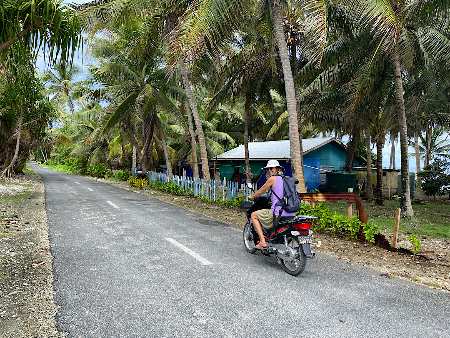
Provisioning
The best grocery store we found is called JY Ocean Trading Supermarket. From the dinghy landing it’s on the main road (called Tuvalu Road) and north. It’s not a short walk, but if you take it slow and stay in the shady spots you’ll be there before you know it.
JY Ocean Trading Supermarket has a lot of freezer options for all kinds of meat and frozen vegetables. We also found fresh apples, carrots, pears, enormous cabbage and bok choy, onions and potatoes. They had some basics like powdered milk, flour, rice and a weirdly big selection of cereals like Choco-pops and Weet-a-bix.
There are a lot of smaller markets for groceries as well, but less well-stocked and none had fresh vegetables beyond onions and potatoes when we checked. For eggs, the atoll doesn’t seem to have any chicken farmers (though we did see a handful of chickens in some yards). So eggs only come with the supply boat, which comes once a month. Apparently eggs disappear quickly once they come in.
Wining and dining
We had a pleasant lunch at the Funafuti Lagoon Hotel restaurant. Two items on the menu: Chicken in Oyster Sauce (AUD$18) and Stir Fried Shrimp (AUD$21). Both served with what was once frozen vegetables and white rice. Delicious, if expensive.
Sue’s Kitchen, north from the dinghy dock on Fongafale Road, was also tasty. We had the day’s special of Chicken Curry and it was delicious, AUD$12 per plate. She also offers fish and chips, burger and chips, sandwiches, and roast chicken and chips.
Our other meal out was at Halavai Restaurant on Tuvalu Road. This is Chinese food. I had the Chicken Chowmein and Harry had Chili Chicken. Both tasty at AUD$9 per plate. Enormous servings. A lot of locals (what am I saying – they’re all locals since we were possibly the only visitors on the island while we were here) came in for lunch, boys and men eating pile of food that would feed a family of four.


Boat repair parts and hardware
There’s a hardware store on Tuvalu Road north of the government building. It’s called Ocean Hardware and you’ll find bolts, washers, outboard engines and similar items.
It’s across the street from the JY Ocean Trading Supermarket. There’s also a shop nearby on the same street called Nang Store that has a bizarre supply of things like a small inverter, motorbike batteries, carburetors (not sure if for motorbike or outboard engine) and similar.
What’s next?
We really enjoyed Tuvalu. This place was meant to be a quick stop, and it will still be that, but now I feel it prying into my heart with its perfect little road for motorbikes edged with palm trees and flowering bushes.
The land of this country is impossible, a narrow strip about 700 feet/200 meters wide and 7.5 miles/12 kilometers long. There’s one main road traveling this arc and at night we can see the jumpy lights of mopeds as they motor at responsible, slow speeds from one end to the other. It feels restful, relaxing, peaceful here.
We’re keeping our eye on weather windows for our next hop to Majuro, Marshall Islands, about a 9-day passage.
Captain Harry Pattison and First Mate Joy Archer,
Oh Joy II
…………………………………
About the Authors
Captain Harry Pattison and Joy Archer sail aboard Oh Joy II, a Mason 44 monohull which has a draft of 6.5 ft. Their home port is Bainbridge Island in the state of Washington, United States.
Their cruising has taken them south along the west coast of the US and Mexico then west across the Pacific to French Polynesia, American Samoa, Fiji, and New Zealand. To close the loop the are sailing from New Zealand to Tonga to Tuvalu to Marshall Islands and finally all the way north to Sitka, Alaska.
…………………………………
The opinions expressed in this article are the author’s own and do not reflect the view of Noonsite.com or World Cruising Club
.………………………………..
Find out all news, reports, links and comments posted on Noonsite, plus cruising information from around the world, by subscribing to our FREE monthly newsletter. Go to https://www.noonsite.com/newsletter/.
Related to following destinations: Alaska, Funafuti, Majuro, Marshall Islands, New Zealand, Outer Atolls (Tuvalu), Tonga, Tuvalu, USA
Related to the following Cruising Resources: Off the Beaten Path, Pacific Crossing, Routing




